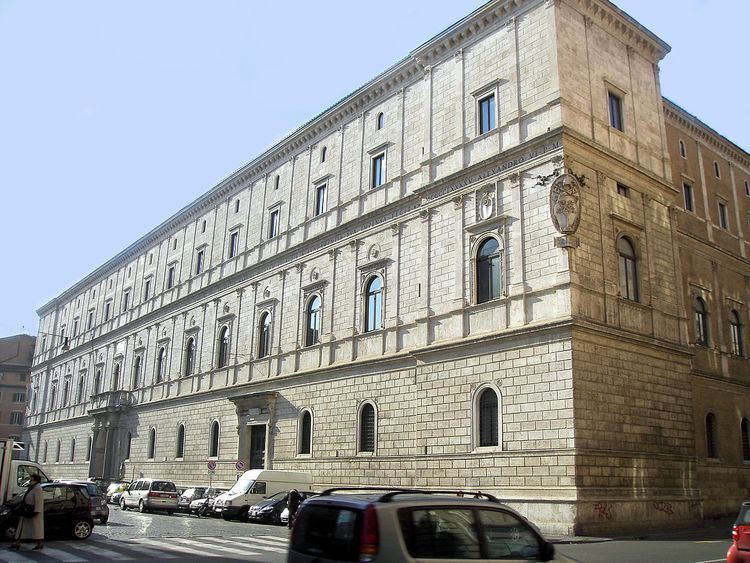Height 25 m Construction started 1489 Architect Donato Bramante | Opened 1513 Burials Aulus Hirtius | |
 | ||
Similar Palazzo Farnese, San Lorenzo in Damaso, Palazzo Venezia, Palazzo Massimo alle Colo, Palazzo di Propaganda Fide | ||
The Palazzo della Cancelleria (Palace of the Chancellery, referring to the former Apostolic Chancery of the Pope) is a Renaissance palace in Rome, Italy, situated between the present Corso Vittorio Emanuele II and the Campo de' Fiori, in the rione of Parione. It was built between 1489–1513 by Donato Bramante (1444–1514) as a palace for Cardinal Raffaele Riario, Camerlengo of the Holy Roman Church, and is regarded as the earliest Renaissance palace in Rome. The Palazzo houses the Papal Chancellery, is an extraterritorial property of the Holy See, and is designated as a World Heritage Site.
Contents
As of 2015, it was the residence of retired Cardinal Bernard Law of Boston, United States.
Roma palazzo della cancelleria manortiz
History
The Cancelleria was built for Cardinal Raffaele Riario who held the post of Cardinal Camerlengo to his powerful uncle, Pope Sixtus IV. The rumor was that the funds came from a single night's winnings at gaming. The edifice has traditionally been attributed to Donato Bramante and Andrea Bregno. Current opinion of the architect's identity is divided, with Francesco di Giorgio Martini and Baccio Pontelli suggested as having been involved in the early stages of its design.
In 1517, the newly completed Palazzo was seized by the first Medici Pope, Leo X, who had not forgotten the complacency of Pope Sixtus (which?) at the time of the murderous Pazzi conspiracy intended to replace the Medici in Florence, Italy with a Della Rovere regime. From 1753 the vice chancellor was the Jacobite pretender to the throne of Great Britain, Henry Stuart, Cardinal Duke of York, the Jacobite "Henry IX of Great Britain". During the late 17th century former Queen Kristina of Sweden resided here.
During the Roman Republic of 1849 the parliament briefly sat here.
Architecture
The Palazzo della Cancelleria was the first palazzo in Rome to be erected from the ground up in the new Renaissance style. Its long facade engulfs the small Basilica di San Lorenzo in Damaso, the Cardinal's titular church, that is to its right, with the palatial front continuing straight across it. The entrance to the Basilica is on the right side of the facade. The 5th-century basilica (its interior has been rebuilt) sits, like the Basilica di San Clemente among others, on a pagan Roman mithraeum. Excavations beneath the cortile from 1988 to 1991 revealed the 4th- and 5th-century foundations of the grand Basilica di San Lorenzo in Damaso, founded by Pope St. Damasus I, and one of the most important early churches of Rome. A cemetery in use from the 8th century until shortly before the construction of the Palazzo was also identified.
The facade, with its rhythm of flat doubled pilasters between the arch-headed windows, is Florentine in conception, comparable to Leone Battista Alberti's Palazzo Rucellai. The overall pattern of drafted masonry, cut with smooth surfaces and grooves around the edges, is ancient Roman in origin. The grand portal was added in the 16th century by Domenico Fontana on the orders of Cardinal Alessandro Farnese.
The bone-colored travertine of the Palazzo was spolia from the nearby ancient ruins of the Theatre of Pompey, for Rome was a field of ruins, built for a city of over one million that then housed a mere 30,000. The 44 Egyptian granite columns of the inner courtyard are from the porticoes of the theatre's upper covered seating, however they were originally taken from the theatre to build the old Basilica di San Lorenzo in Damaso. Filippo Brunelleschi's cloisters of the Basilica di Santa Croce in Florence, which may have also inspired the courtyard of Luciano Laurana's Palazzo Ducale in Urbino (circa 1468) has been suggested as a possible source of inspiration. It is more probable that the form of the courtyard is derived from that of the Ducal Palace in Urbino, because the individuals involved in the early planning of the Palazzo had come from Urbino.
In the Palazzo is a vast mural that Giorgio Vasari completed in a mere 100 days, therefore named the Sala dei Cento Giorni. He boasted of this accomplishment to Michelangelo, who responded "Si vede" ("It shows"). In the Palazzo a little, private theatre was installed by Cardinal Pietro Ottoboni, and in the later 17th century the Palazzo became a center of musical performance in Rome.
